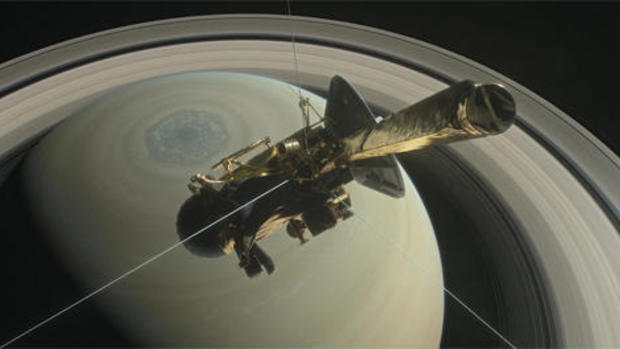NASA's Cassini spacecraft phones home after daring Saturn encounter
NASA's Cassini spacecraft is back in contact with Earth, agency official said Thursday, beaming back data and telemetry one day after the first of 22 planned high-speed plunges through the gap between Saturn's cloud tops and its vast ring system.
Virtually out of gas after 13 years orbiting the gas giant, Cassini is finishing up its enormously successful $3.9 billion mission by repeatedly shooting the gap between the planet and its rings, collecting a final set of unprecedented close-range data before crashing into Saturn's atmosphere in September.
The spacecraft shot the gap for the first time early Wednesday, passing within just 1,900 miles of Saturn's cloud tops -- and a scant 200 miles from the visible edge of the innermost rings -- at a velocity of some 77,000 miles per hour, fast enough to fly across 375 football fields, end to end, in one second.
Scientists were confident Cassini would not encounter any large ring particles, but they could not be certain and given the spacecraft's enormous velocity, the probe was oriented with its large dish antenna facing forward to act as a shield.
As a result, Cassini was out of contact until it could complete its science observations and aim itself back toward Earth to resume beaming data back to anxious scientists.
After crossing the 872-million-mile gulf between Saturn and Earth, the initial post-crossing signal reached NASA's Deep Space Network antennas at Goldstone, Calif., at 2:56 a.m. EDT Thursday and data began streaming in five minutes later.
"No spacecraft has ever been this close to Saturn before," Earl Maize, the Cassini project manager, said in a statement. "We could only rely on predictions, based on our experience with Saturn's other rings, of what we thought this gap between the rings and Saturn would be like.
"I am delighted to report that Cassini shot through the gap just as we planned and has come out the other side in excellent shape."
Launched in October 1997, Cassini arrived at Saturn in July 2004 and dropped off a lander built by the European Space Agency that successfully completed a parachute descent to the surface of Titan the following January.
Since then, Cassini has flown through a complex set of ever-changing orbits, repeatedly using the gravity of Saturn's large moon Titan to alter its course, enabling multiple flybys of Saturn, its huge ring system and many of its moons, earning two mission extensions in the process.
The spacecraft has operated in near flawless fashion, chalking up one of NASA's most scientifically productive planetary missions. But Cassini has used up just about all of its propellant and once it runs out, the spacecraft will no longer be controllable.
To ensure the probe does not someday crash into a moon like Enceladus, where a subsurface ocean may provide an abode for life, NASA managers decided to put Cassini on a trajectory that will culminate in a mission-ending plunge into Saturn's atmosphere on Sept. 15.
The "Grand Finale" trajectory, set up with a final close-range flyby of Titan on April 22, will enable scientists to get a closer view of the planet's turbulent atmosphere than ever before, enabling unprecedented observations of its gravitational and magnetic fields and help researchers calculate the mass of the ring system to determine its age.
Cassini will make the second of 22 planned ring plane crossings May 2.
"In the grandest tradition of exploration, NASA's Cassini spacecraft has once again blazed a trail, showing us new wonders and demonstrating where our curiosity can take us if we dare," Jim Green, NASA's director of planetary science, said in the agency's post-crossing statement.






